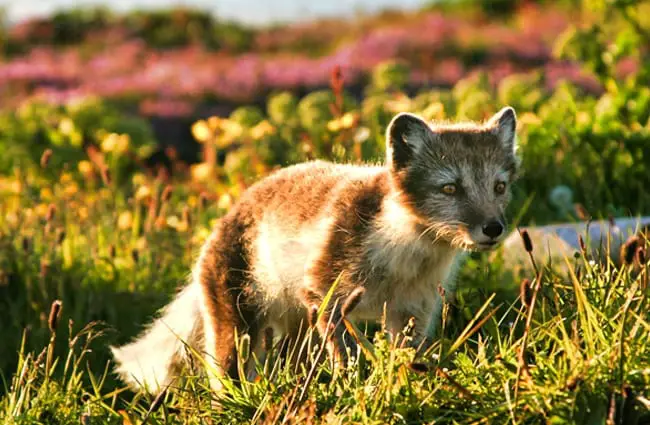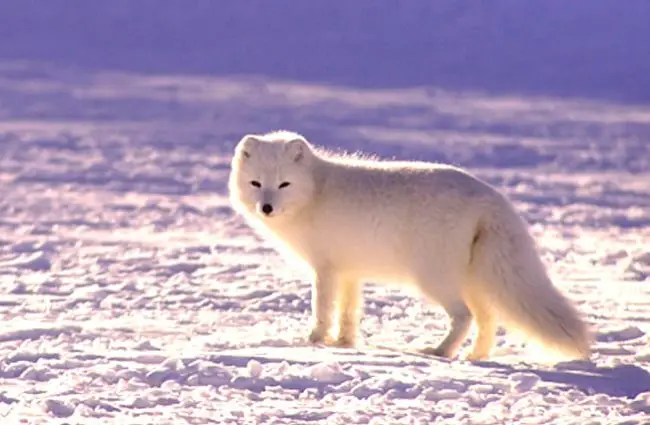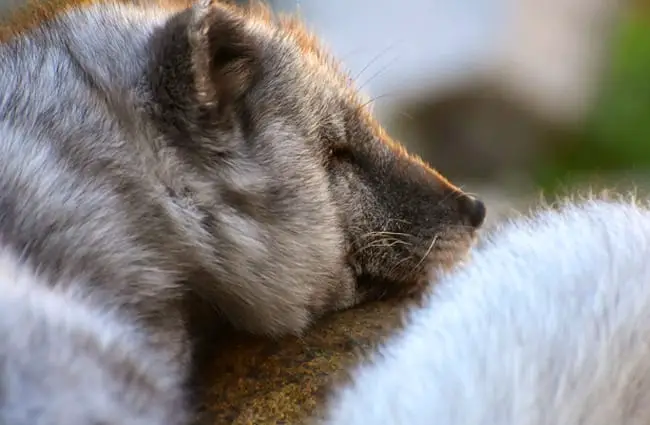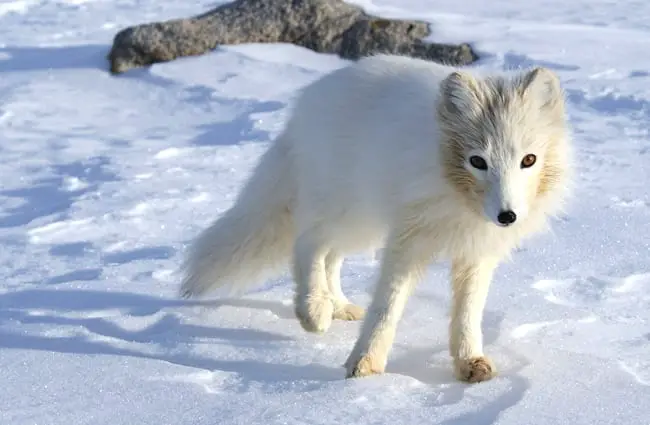The Arctic fox, a creature of remarkable resilience and beauty, thrives in one of Earth’s most unforgiving environments. This captivating canid, scientifically known as Vulpes lagopus, embodies adaptation, showcasing a mastery of survival in the frigid landscapes of the Arctic regions. From its iconic white coat to its ingenious hunting strategies, the Arctic fox is a testament to the power of natural selection.

Understanding the Arctic Fox
Habitat and Distribution
The Arctic fox is circumpolar, meaning its range encircles the Arctic. It inhabits the Arctic regions of North America, Europe, and Asia. These adaptable creatures occupy a diverse range of habitats within the Arctic, including tundra, ice floes, and coastal areas. They establish dens in earth banks, snowdrifts, or rocky areas, often choosing locations with good visibility and access to hunting grounds.
Physical Characteristics
The Arctic fox is a relatively small canid, typically measuring between 18 and 27 inches in length, with a weight ranging from 6 to 14 pounds. Its most recognizable feature is its dense, insulating fur coat. This coat undergoes seasonal changes, becoming pure white in winter for camouflage against the snow and ice, and transitioning to a darker, brownish or grayish hue in summer to blend with the tundra vegetation. This seasonal color change is not uniform across all populations. Some Arctic foxes, particularly those in coastal areas, maintain a blue gray coat year round. The fox’s compact body shape, short legs, and densely furred paws help minimize heat loss and provide traction on ice and snow.

Evolutionary History
The evolutionary origins of the Arctic fox can be traced back to the Pleistocene epoch. It is believed to have diverged from other fox species relatively recently, adapting to the harsh conditions of the Arctic tundra. Fossil evidence suggests that the species underwent significant adaptations to survive in the cold, including the development of its dense fur, compact body shape, and specialized paws. Its ability to thrive in extreme environments demonstrates the power of natural selection in shaping species to their ecological niches.
Diet and Hunting Strategies
What Does an Arctic Fox Eat?
The Arctic fox is an opportunistic feeder, meaning its diet varies depending on the availability of prey. Lemmings are a staple food source for many Arctic fox populations. When lemming populations are high, foxes will cache surplus prey, storing it in snow dens for later consumption. Other important food sources include voles, hares, birds, eggs, fish, and carrion. Coastal populations also rely on marine resources, such as seals, seabirds, and shellfish.
Hunting Techniques
Arctic foxes employ a variety of hunting techniques. They often use their keen sense of smell to locate prey under the snow. They will dig through the snow to unearth lemmings and other small mammals. They may also stalk prey, using their camouflage to blend in with the environment. In coastal areas, they will scavenge on carcasses of seals killed by polar bears. They are known to follow polar bears, feeding on the scraps left behind, a mutually beneficial relationship in a harsh environment.

Reproduction and Life Cycle
Mating and Denning
Arctic foxes typically form monogamous pairs, mating in the spring. The gestation period is approximately 52 days. The vixen, the female fox, gives birth to a litter of pups in a den. Litter sizes vary depending on food availability, ranging from 5 to 12 pups. The den provides protection from predators and the elements. The pups are born blind and helpless, relying entirely on their mother for care.
Pup Development
The pups begin to develop rapidly, opening their eyes after about two weeks. They are weaned from their mother’s milk at around four to six weeks of age. They begin to explore outside the den, learning to hunt and forage from their parents. The pups typically reach independence by the fall, dispersing to establish their own territories. Survival rates are highly variable, depending on food availability and predation pressure.
Ecological Role and Interactions
The Arctic Fox as a Predator and Prey
The Arctic fox plays an important role in the Arctic ecosystem as both a predator and prey. As a predator, it helps to regulate populations of small mammals and birds. It also scavenges on carrion, contributing to nutrient cycling. As prey, it is targeted by larger predators, such as wolves, polar bears, and golden eagles. It also competes with other predators, such as the red fox, for resources.

Impact of Climate Change
Climate change poses a significant threat to the Arctic fox. The warming Arctic is leading to a reduction in sea ice, which affects the availability of marine resources. It is also causing shifts in vegetation patterns and prey distributions. The encroachment of the red fox into Arctic fox territories is increasing competition for resources. These changes are impacting the survival and reproduction of Arctic fox populations.
Arctic Foxes and Humans
Historical and Cultural Significance
Arctic foxes have a long history of interaction with humans, particularly indigenous cultures in the Arctic regions. They were traditionally hunted for their fur, which was used to make clothing and other items. The foxes also hold cultural significance in the mythology and folklore of many Arctic communities. Their resilience and adaptability have been admired for generations.
Current Conservation Status
The Arctic fox is currently listed as Least Concern by the International Union for Conservation of Nature (IUCN). However, some populations are declining due to climate change and competition with the red fox. Conservation efforts are focused on monitoring population trends, protecting critical habitats, and mitigating the impacts of climate change.

Encountering an Arctic Fox in the Wild
If you are fortunate enough to encounter an Arctic fox in the wild, it is important to observe it from a safe distance. Avoid approaching or feeding the animal. Do not disturb its den or young. Report any unusual behavior or sightings to local wildlife authorities. Remember that these are wild animals and should be treated with respect.
For the Aspiring Zoologist
Detailed Physiological Adaptations
Beyond the well‑known dense fur, the Arctic fox exhibits remarkable physiological adaptations. Countercurrent heat exchange in the extremities minimizes heat loss. A high metabolic rate generates sufficient body heat to maintain core temperature in subzero conditions. Body fat reserves provide insulation and energy storage. The fox’s circulatory system is also adapted to regulate blood flow to the extremities, preventing frostbite.
Population Dynamics and Genetic Diversity
Studying Arctic fox populations requires understanding their complex dynamics. Population size fluctuates dramatically, often linked to cyclical lemming abundances. Genetic diversity varies between populations, with isolated groups exhibiting lower diversity. Researchers use techniques like mark‑recapture and genetic analysis to monitor population trends and assess the health of different groups.
Captive Care Considerations
Caring for Arctic foxes in captivity requires careful attention to their specific needs. Provide spacious enclosures with substrate suitable for digging and denning. Offer a varied diet that mimics their natural prey, including small mammals, birds, and fish. Enrich the environment with stimulating objects and activities. Monitor their health closely and provide regular veterinary care. Avoid overcrowding and ensure adequate social interaction.
The Arctic fox stands as a symbol of resilience and adaptation in one of Earth’s most challenging environments. Its story is a reminder of the interconnectedness of life and the importance of conserving biodiversity in the face of a changing world. Continued research and conservation efforts are crucial to ensure the survival of this remarkable species for generations to come.

![Red Angus Closeup of a beautiful Red Angus cowPhoto by: U.S. Department of Agriculture [pubic domain]https://creativecommons.org/licenses/by/2.0/](https://animals.net/wp-content/uploads/2020/03/Red-Angus-4-238x178.jpg)




![Red Angus Closeup of a beautiful Red Angus cowPhoto by: U.S. Department of Agriculture [pubic domain]https://creativecommons.org/licenses/by/2.0/](https://animals.net/wp-content/uploads/2020/03/Red-Angus-4-100x75.jpg)

